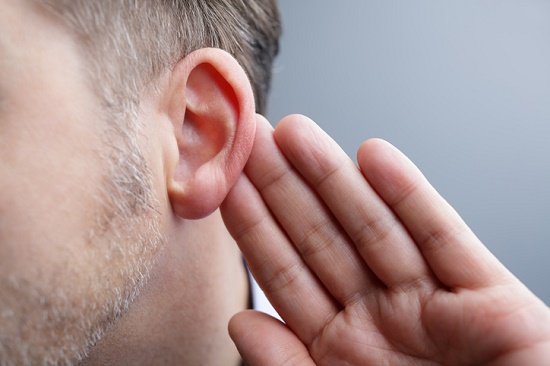
Your chances of acquiring hearing loss at some point in your life are unfortunately very high, even more so as you grow older. In the US, 48 million people report some degree of hearing loss, including just about two-thirds of adults age 70 and older.
That’s why it’s important to understand hearing loss, so that you can recognize the symptoms and take preventive measures to prevent damage to your hearing. In this article, we’re going to concentrate on the most common form of hearing loss: sensorineural hearing loss.
The three types of hearing loss
Generally speaking, there are three forms of hearing loss:
- Conductive hearing loss
- Sensorineural hearing loss
- Mixed hearing loss (a mix of sensorineural and conductive)
Conductive hearing loss is less common and is caused by some kind of obstruction in the outer or middle ear. Frequent causes of conductive hearing loss include impacted earwax, ear infections, benign tumors, perforated eardrums, and hereditary malformations of the ear.
This article will focus on sensorineural hearing loss as it is by far the most common.
Sensorineural hearing loss
This type of hearing loss is the most common and makes up about 90 percent of all reported hearing loss. It is the result of injury to the hair cells (the nerves of hearing) of the inner ear or to the nerves running from the inner ear to the brain.
With sensorineural hearing loss, sound waves enter the outer ear, hit the eardrum, and arrive at the inner ear (the cochlea and hair cells) as normal. However, on account of damage to the hair cells (the very small nerve cells of hearing), the sound signal that is presented to the brain for processing is diminished.
This weakened signal is perceived as faint or muffled and normally affects speech more than other kinds of lower-pitched sounds. Additionally, contrary to conductive hearing loss, sensorineural hearing loss tends to be permanent and can’t be corrected with medication or surgery.
Causes and symptoms
Sensorineural hearing loss has a variety of possible causes, including:
- Genetic disorders
- Family history of hearing loss
- Meniere’s Disease or other disorders
- Head injuries
- Benign tumors
- Exposure to loud noise
- Aging (presbycusis)
The last two, direct exposure to loud noise and aging, constitute the most common causes of sensorineural hearing loss, which is actually good news as it shows that most cases of hearing loss can be avoided (you can’t avoid aging, of course, but you can regulate the cumulative exposure to sound over your lifetime).
To fully grasp the symptoms of sensorineural hearing loss, you should remember that injury to the nerve cells of hearing usually happens very gradually. Therefore, the symptoms advance so gradually that it can be virtually impossible to detect.
A slight measure of hearing loss every year will not be very recognizable to you, but after many years it will be very noticeable to your family and friends. So while you may believe everyone is mumbling, it might be that your hearing loss is catching up to you.
Here are some of the symptoms to look for:
- Difficulty understanding speech
- Difficulty following conversions, particularly with more than one person
- Turning up the television and radio volume to unreasonable levels
- Regularly asking others to repeat themselves
- Experiencing muffled sounds or ringing in the ears (tinnitus)
- Becoming exceedingly exhausted at the end of the day
If you recognize any of these symptoms, or have had people tell you that you might have hearing loss, it’s a good idea to arrange for a hearing exam. Hearing tests are easy and painless, and the earlier you treat hearing loss the more hearing you’ll be able to preserve.
Prevention and treatment
Sensorineural hearing loss is mostly preventable, which is great news since it is without question the most common form of hearing loss. Millions of instances of hearing loss in the United States could be avoided by adopting some simple precautionary measures.
Any sound above 80 decibels (the volume of city traffic inside your car) can potentially harm your hearing with sustained exposure.
As the decibel level increases, the amount of time of safe exposure decreases. That means at 100 decibels (the volume of a rock concert), any exposure over 15 minutes could damage your hearing.
Here are some tips on how you can prevent hearing loss:
- Use the 60/60 rule – when listening to a mp3 player with headphones, listen for no more than 60 minutes at no more than 60 percent of the maximum volume. Also consider investing in noise-canceling headphones, as these will require lower volumes.
- Shield your ears at live shows – concerts can vary from 100-120 decibels, far above the threshold of safe volume (you could damage your hearing within 15 minutes). Limit the volume with the aid of foam earplugs or with musician’s plugs that preserve the quality of the music.
- Protect your ears at work – if you work in a loud occupation, talk with your employer about its hearing protection program.
- Protect your hearing at home – a number of household and recreational activities produce high-decibel sounds, including power saws, motorcycles, and firework displays. Make sure that you always use ear protection during prolonged exposure.
If you already have hearing loss, all is not lost. Hearing aids, while not able to completely restore your hearing, can substantially improve your life. Hearing aids can enhance your conversations and relationships and can protect against any further consequences of hearing loss.
If you think you might have sensorineural hearing loss, book your quick and easy hearing test today!
